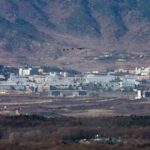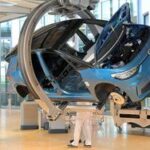Why South Korea’s Dokdo-Class Ships Are the Navy’s Best-Kept Secret in Amphibious Operations
Daniel Kim Views

The South Korean Navy has significantly used its Dokdo-class transport ships in recent years. The Dokdo, a 14,000-ton vessel, played a crucial role during the search and rescue operations following the tragic ferry Sewol sinking in 2014 and the Cheonan sinking in 2010. This ship effectively served as the command center for these rescue missions, demonstrating its vital role in critical situations.
The Republic of Korea Navy operates two Dokdo-class large transport ships (LPHs). Each ship measures 199 meters in length, 31 meters in width, and has a draft of 6.6 meters. They can reach up to 23 knots (about 43 km/h) and cruise at 18 knots (about 33 km/h). With a light displacement of 14,000 tons, they can carry seven helicopters, six tanks, seven amphibious assault vehicles, ten trucks, three artillery pieces, and two fast landing craft. Each vessel also accommodates over 300 crew members and around 700 troops.
The primary mission of these ships is to transport troops and equipment for amphibious operations. In wartime, they act as the flagship for amphibious assaults. They are versatile vessels also used for disaster relief and the evacuation of citizens from abroad during emergencies. The ships have a large well dock for an air-cushion landing craft known as the Fast Landing Craft (LSF-II) and a flight deck for helicopter operations. However, they do not support fixed-wing vertical takeoff and landing aircraft.
The first Dokdo-class ship, named Dokdo, was delivered to the Navy in June 2007 and became operational by 2008. It was named after the remote island of Dokdo off Korea’s eastern coast, symbolizing the protection of South Korea’s maritime territory. The second ship, Marado, was received from Hanjin Heavy Industries in June 2021. This vessel included upgrades based on lessons learned from the Dokdo’s operational use and completed its training before being deployed in October of the same year.
The ship can accommodate up to five helicopters landing simultaneously
The South Korean government initially planned to build a third Dokdo-class transport ship, considering names like ‘Baengnyeongdo’ and ‘Shindo.’ However, budget constraints led to the project being shelved. The pressing need for next-generation destroyers, maritime patrol aircraft, helicopters, submarines, and fast ships took precedence. Consequently, it took 13 years after the first ship, Dokdo, was deployed before the second ship, Marado, became operational.
Dokdo’s most notable feature is its large flight deck, which can accommodate up to five helicopters simultaneously. Unlike typical ships that handle only one helicopter at a time, Dokdo can handle multiple landings. It is also unique in being able to land the heavy-lift CH-47 Chinook helicopter. Its advanced three-dimensional phased array air defense radar allows it to manage hundreds of aircraft simultaneously.
The Dokdo is equipped with dedicated sections for amphibious operations, including two bridges and two situation rooms. It features three dining areas that can seat over 1,200 people at once, with a crew dining room with more than 150. The ship also has sleeping quarters for up to 1,100 personnel.
In addition, Dokdo includes a hangar for air-cushion landing craft and amphibious assault vehicles, enabling their launch at sea. It also offers extensive medical support capabilities to treat and perform surgeries on casualties during amphibious operations.

As the second vessel in the Dokdo class, the Marado closely resembles its predecessor, the Dokdo. However, Marado comes with several enhancements based on the operational feedback from Dokdo. It features advanced multi-phased array radar developed by Israel’s IAI Elta and a domestically developed vertical launch system for the Haegung ship-to-air missile (K-SAAM). These upgrades significantly boost Marado’s performance compared to the original Dokdo. The Haegung missile uses a dual seeker system that combines laser and thermal infrared technology for improved targeting.
Marado’s flight deck has been strengthened to support operations with up to three U.S. Marine Corps MV-22B Ospreys, facilitating joint operations with the U.S. military. However, the ship cannot accommodate the F-35B stealth fighter, which requires a flight deck capable of withstanding high temperatures and a runway of at least 150 meters for its short takeoff and vertical landing capabilities.
A Defense Acquisition Program Administration official explained, “Marado, as the Republic of Korea Navy’s second large transport ship, builds on the capabilities of Dokdo. It serves vital command functions for amphibious operations and is named after ‘Marado,’ the southernmost island, symbolizing our commitment to protecting the waters around the Korean Peninsula.”
Some suggest converting the large transport ship into a light aircraft carrier
There have been suggestions to repurpose the large transport ship Marado as a light aircraft carrier, with claims that it could accommodate up to seven F-35B fighters capable of short takeoff and vertical landing. However, transforming either Dokdo or Marado into a functioning aircraft carrier is not feasible.
The heat of jet fighters during takeoff is much more intense than that of rotary-wing aircraft. This would require a complete overhaul of the flight deck at a significant cost. The ship would also need extensive modifications, including changes to the deck and elevators. These renovations would be as costly and time-consuming as building a new vessel, making the idea impractical.
Speed is another issue. While Dokdo and Marado can reach a maximum speed of 23 knots, this is notably slower than the 30-knot speeds of Aegis destroyers and frigates. This slower speed would impact the overall effectiveness of a carrier strike group. Consequently, the Navy has no plans to modify Dokdo or Marado for aircraft carrier roles.















Most Commented